
The Two Gold Bangles were crafted from gold and date back to the period between the third century BCE and the third century CE. They were used as adornments and decorative accessories and were discovered at Qaryat al-Faw Archaeological Site , located southeast of Wadi ad-Dawasir Governorate in Riyadh Province , in the Kingdom of Saudi Arabia. Each of the two bangles features a brown agate bead, with each bead exhibiting a faint white streak. The bangles take the shape of small shields, adorned ...
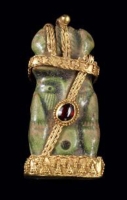
The Gold Pendant is a rectangular-shaped pendant made of ceramic, discovered in Qaryat al-Faw Archaeological Site , southeast of Wadi ad-Dawasir Governorate , Riyadh Province , Kingdom of Saudi Arabia. It dates back to the period between the third century BCE and the third century CE and was used as an ornamental accessory. Specifications of the gold pendant The base of the gold pendant measures 1.6 cm × 1.2 cm, a width of 1.5 cm, and a height of 3.8 cm. The pendant's surface features rai...
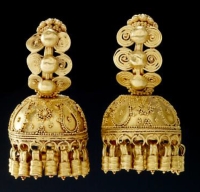
The Two Gold Earrings are a pair of gold earrings discovered at Qaryat al-Faw Archaeological Site , located in the southeastern part of Wadi ad-Dawasir Governorate in Riyadh Province , in the Kingdom of Saudi Arabia. The earrings weigh 15.9 g. They date back to the period between the third century BCE and the third century CE and were used as ornamental jewelry for women. Manufacturing method Each earring was crafted in the shape of a Koufia , from which a row of rings hangs, e...
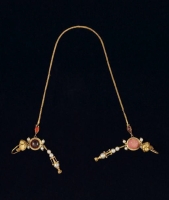
The Archaeological Jawan Necklace is a golden chain measuring 41.5 cm in length, ending in two terminals, each adorned with a ruby-studded earring. It features two golden side ends shaped like a pearl ewer. It was discovered in Jawan Tomb, located in Ain Jawan, an archaeological and historical site situated in the northwestern corner of Tarout Bay, at the northernmost point of al-Qatif City, and southeast of Safwa City, in the Eastern Province of the Kingdom of Saudi Arabia. History of Jawan ne...
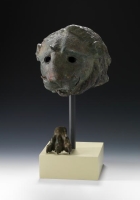
The Lion’s Head and Claw is a bronze artifact consisting of a lion’s head and part of its neck, discovered in al-Okhdood Archaeological City , located in al-Qabil Village, on the southern bank of Wadi Najran, in the south part of Najran Province , in the Kingdom of Saudi Arabia. The area is rich in historical artifacts. Details of the face are visible on the lion’s head and the end of its paw. A section of the loop appears as a braided plait that wraps behind the ears and encircles the ne...

The Bronze Frieze is one of the archaeological artifacts selected to participate in the Saudi Archeological Masterpieces Through the Ages Exhibition , held at the Louvre Museum in the French capital, Paris, in 2010. The exhibition featured three hundred pieces representing various materials and historical periods, sourced from different provinces of the Kingdom of Saudi Arabia. These artifacts are categorized according to their historical sequence into three groups: prehistoric artifacts, pre-I...
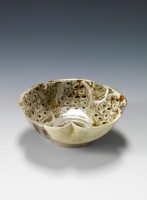
The Ancient Ceramic Bowl is an archaeological artifact made of metallic-luster ceramic. It features a wide basin, a foliated rim, and a flat circular base. The exterior surface is adorned with longitudinal and transverse lines, while the interior surface displays geometric and botanical motifs. The bowl was selected to be part of the Archaeological Masterpieces Through the Ages Exhibition, held at the Louvre Museum in Paris, the capital of France, in 2010. History of the ceramic bowl The cerami...
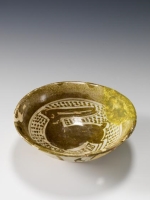
The Ceramic Plate Featuring a Gazelle Design is a small archaeological artifact made of metallic-luster ceramic. It was discovered in al-Rabatha Historical Area, one of the significant archaeological sites along the Hajj route from Kufa to Makkah al-Mukarramah . The site is located approximately two hundred km east of al-Madinah al-Munawwarah , along the western edge of the Hejaz Mountains , in the Kingdom of Saudi Arabia. Specifications of the ceramic plate A section of the plate’s rim and b...
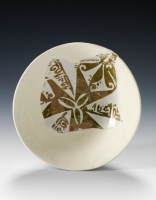
The Ancient Ceramic Dish is an archaeological artifact consisting of a fragment from the base and body of a dish made of ceramic with a metallic luster. Both surfaces feature inscriptions and botanical decorations in an olive-green hue. It was discovered in al-Mabiyat, a village in AlUla Governorate , part of al-Madinah al-Munawwarah Province in the Kingdom of Saudi Arabia. The site is located approximately twenty km from AlUla and about three hundred km north of al-Madinah al-Munawwarah . Hist...
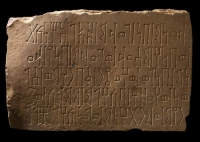
The Inscribed Stone is a rectangular-shaped sandstone block discovered at the Qaryat al-Faw Archaeological Site , located at the junction of Wadi ad-Dawasir and the Tuwaiq Mountains range, in the southeast of Wadi ad-Dawasir Governorate in Riyadh Province , Kingdom of Saudi Arabia. Description of the stone The edges of the stone are eroded, and the block appears to have been roughly cut. It has a smooth surface and is divided into five lines of text inscribed in the ancient South Arabian Musnad...
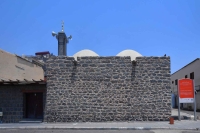
Ad-Dir’ Mosque is one of the historic mosques in the Kingdom of Saudi Arabia. It is located in al-Madinah al-Munawwarah between the Prophet’s Mosque and Mount Uhud . One of its names, al-Udwah Mosque, derives from its position on the roadside ( Udwah ). It is also referred to as al-Sheikhayn Mosque, named after a location on the route between the Prophet’s Mosque and Mount Uhud along the eastern path with al-Harr to Mount Uhud. Additionally, it is called al-Badai' Mosque. The mosque ...
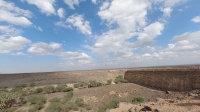
Al-Madinah al-Munawwarah is home to several archaeological dams built by caliphs and princes during the Early Islamic Era. It also comprises other monuments and landmarks located within and around al-Madinah al-Munawwarah as well as historical castles, fortresses, and ports, including al-Jar Port overlooking the Red Sea. Archaeological dams in the province include: - Al-Bint Dam. - Haseed Dam in Khaybar Governorate . - Muawiyah Bin Abi Sufyan Dam, built in 670. It is located in Wadi al-Khunaiq,...